LINEAR ALGEBRA
Second Edition
KENNETH
Professor of Mathematics
Massachusetts
Institute
HOFFMAN
of Technology
RAY KUNZE
Professor of Mathematics
University
of California,
Irvine
PRENTICE-HALL,
INC., Englewood Cliffs, New Jersey
�
@ 1971, 1961 by
Prentice-Hall,
Englewood
Inc.
Cliffs, New
Jersey
All rights
reproduced
permission
in any
in writing
reserved. No part of this book may be
form or by any means without
from
the publisher.
PRENTICE-HALL~NTERNATXONAL,INC.,
PRENTICE-HALLOFAUSTRALIA,PTY.
PRENTICE-HALL
PRENTICE-HALLOFINDIA
PRENTICE-HALL
OF CANADA,
OFJAPAN,INC.,
London
LTD., Sydney
LTD.,
PRIVATE
Toronto
LIMITED,
New Delhi
Tokyo
Current
printing
(last digit)
:
10
9 8
7 6
Library
Printed
of Congress Catalog Card No. 75142120
in the United States of America
�
Pf re ace
Our original
purpose
in writing
from
ranged
linear algebra
graduate
course was designed
fourths of the students were drawn
and
M.I.T.
the
the country
basic material
sity
audience
first edition
for the
text
have seen
and have afforded
to a variety
freshmen
and
course at the Massachusetts
at
for mathematics
this book was to provide
Institute
junior
and
the
from other scientific
majors
for
a text
of Technology.
level, although
the under-
This
three-
disciplines
through
remains
the proliferation
graduate
generally
students.
accurate
technological
This
description
today. The
the
ten years since
of
of linear
algebra
courses
throughout
one of the authors
the opportunity
of groups at Brandeis University,
to
Washington
teach
the
Univer-
(St. Louis),
Our principal
the University
in revising
of California
(Irvine).
Linear Algebra has been
to
increase
the variety
aim
especially
the way, allowing
to exercise a considerable
of courses which can easily be taught
chapters,
the more difficult
ping points along
course
other hand, we have
used
reference book
The major
comprehensive
for mathematicians.
changes have been
In Chapter
the
for a rather
increased
spaces.
theory of canonical
the
amount
the amount
one-year
from
ones, so that
it. On one hand, we have structured
there are several natural
the
stop-
instructor
in a one-quarter
or one-semester
of choice
of material
course
in
in
the subject matter. On
in the
linear
the
it can be
and even as a
text, so that
algebra
in our
treatments
of canonical
forms and
6 we no longer begin with
the general
forms. We first handle
spatial
characteristic
then build
triangulation
and diagonalization
theorems
and
the general
theory. We have split Chapter
8 so that
the basic material
spaces and unitary
diagonalization
is followed by a Chapter
forms and
operators
the more sophisticated
on real
inner product
properties
spaces.
of normal
product
which underlies
in relation
to
up
inner product
treats
tors,
to
sesqui-linear
including
We have also made a number
normal
first edition.
But
the basic philosophy
We have made no particular
course should
students may not be primarily
matics
of
hodgepodge
basic mathematical
techniques,
concepts.
of small
behind
concession
changes and
the
to
fact
text
the
interested
in mathematics.
improvements
from
the
is unchanged.
the majority
that
of the
For we believe a mathe-
not give science, engineering,
or social science
students
but
should
provide
them with an understanding
inner
theory
values
our way
on
9 which
opera-
a
of
. . .
am
�
Preface
On
grounds which
students
For
this
the very beginning
presents
it most profitable
to read
students
such basic
Throughout
theorem,
important
importance
tion,
concepts.
hundred),
best students.
the other hand, we have been keenly
the students may possess and,
of the
experience with abstract mathematical
aware of the wide
in particular,
range of back-
the
fact
that
reasoning.
have had very
reason, we have avoided
little
the
introduction
of too many abstract
In addition,
we have
included
an Appendix
relation. We have
independently,
but
to advise
ideas at
which
found
the
of the book.
ideas as set, function,
not
to dwell on
the Appendix
when
the book we have
and equivalence
ideas
ideas arise.
a great
these
these
included
concepts which occur. The study of such examples
and
the number
to minimize
tends
proof
in logical order without
The book also contains
ranging
routine
from
These exercises are
applications
intended
1 deals with systems of linear equations
row operations
this material.
on matrices.
It provides
of the more abstract
ideas occurring
the computational
variety
of examples
is of fundamental
of the
of students who can repeat defini-
of the abstract
the meaning
grasping
to ones which will extend
to be an
important
and
their solution
It has been our practice
the student with
technique
the
later
in
some picture
necessary
(about
part of the
six
the very
text.
by means
to spend about
of the
to under-
chapters. Chap-
Chapter
3 treats
a wide variety
of graded
exercises
spaces, subspaces, bases, and dimension.
their algebra,
representation
their
and dual spaces. Chapter
ideals
in
that algebra,
roots, Taylor’s
and
formula,
and
formula.
5 develops
being viewed as an alternating
Chapter
determinants
of square matrices,
n-linear
function
of the
on modules
to multilinear
functions
the concept of determinant
in elementary
a discussion of the concepts which are basic
on modules
is usually
setting
places
found
than
on a finite-dimensional
vector space;
on
the
(eigen)
functionals,
over a field,
transformation
then proceeds
It also deals with
transformations,
linear
Chapter
of elementary
six
lectures
origins of linear algebra and with
stand examples
ter 2 deals with vector
linear
isomorphism,
polynomials
a polynomial.
polation
minant
and
The material
comprehensive
and 7 contain
linear
teristic
cepts of the diagonalizable
and the rational
theorems
admissible
domain,
and
cussion of semi-simple
Chapter
the basic geometry,
to a vector’
onto a subspace and
unitary
operators.
self-adjoint
of normal
operators
forms, emphasizing
well as groups preserving
pseudo-orthogonal
Chapter
operators
operators
on real or complex
canonical
play a central
subspaces. Chapter
operators,
finite-dimensional
and culminates
9 introduces
relating
to
the development
the computation
on an
and
and Lorentz
and Jordan
operators
8 treats
values,
leading
role,
then
and
triangulable
by matrices,
4 defines
as well as
the algebra of
of
factorization
the prime
the Lagrange
inter-
the deter-
rows of a matrix,
ring.
in a wider and more
6
Chapters
textbooks.
as well as the Grassman
to the analysis of a single
the analysis of charac-
the con-
transformations;
transformation,
and cyclic decomposition
at
the study
through
of
of matrices
over a polynomial
divisors of a matrix,
parts of a more general
and diagonalizable
and nilpotent
canonical
forms. The primary
being arrived
latter
the
7 includes a discussion
of invariant
factors and elementary
of the Smith
canonical
form. The chapter
ends with a dis-
to round
out
inner product
the analysis
of a single operator.
spaces
the
to
in some detail.
It covers
idea of ‘best approximation
of the orthogonal
projection
orthogonalization
the concepts
the orthogonal
complement
of a subspace. The chapter
of a vector
treats
and normal
and
theory
normal
10 discusses bilinear
the spectral
concerning
to positive
in the diagonalization
sesqui-linear
forms,
of self-adjoint
relates
them
inner product
to more
space, moves on to
results
sophisticated
inner product
forms
for symmetric
spaces. Chapter
and skew-symmetric
forms, especially
the orthogonal,
forms, as
unitary,
non-degenerate
groups.
We
feel that any course which uses this
text should
cover Chapters
1, 2, and 3
�
Preface
V
the
thoroughly,
and
determinants,
polynomial
sketchily without
inclination
because
mentary
ter 6, together with
be included,
possibly excluding
Sections 3.6 and 3.7 which deal with
transpose of a linear
transformation.
Chapters
may be
treated
with
varying
degrees of
ideals and basic properties
is to deal with
serious damage
to the
these chapters
so well
illustrates
the material
course may now be concluded
(the new) Chapter
of determinants
logic
flow of the
(except
carefully
ideas of linear
the basic
nicely with
the
the rational
8. If
first
4 and 5, on polynomials
thoroughness.
In
may be covered
the double dual
and
fact,
quite
text; however, our
in the
the results on modules),
algebra. An ele-
four sections of Chap-
forms are to
and Jordan
a more extensive
remains
indebtedness
coverage of Chapter
to
those who contributed
6 is necessary.
to the
first edition,
espe-
Our
cially
to Mrs.
In addition,
ceptive
patience
tion. Lastly,
and her
to Professors Harry Furstenberg,
Judith
Bowers, Mrs. Betty Ann
we would
comments
led
in dealing with
special
thanks
tireless efforts
thank
to
this
like
to
two authors
are due
revision,
(Sargent) Rose and Miss Phyllis
Louis Howard, Daniel Kan, Edward Thorp,
Ruby.
and colleagues whose per-
their
students
the staff of Prentice-Hall
throes of academic
administra-
the many
and
for
caught
to Mrs. Sophia Koulouras
the
for both her skill
in
in
typing
the revised manuscript.
K. M. H.
/ R. A. K.
�
Contents
Chapter
1.
Linear
Equations
Fields
Systems of Linear Equations
1.1.
1.2.
1.3. Matrices
1.4. Row-Reduced
1.5. Matrix Multiplication
1.6.
Matrices
Invertible
Echelon Matrices
and Elementary
Row Operations
Chapter
2.
Vector
Spaces
Vector Spaces
Subspaces
Bases and Dimension
2.1.
2.2.
2.3.
2.4. Coordinates
2.5.
2.6. Computations
Summary
of Row-Equivalence
Concerning
Subspaces
Chapter
3.
Linear
Transformations
Linear Transformations
The Algebra
Isomorphism
3.1.
3.2.
3.3.
3.4. Representation
3.5.
3.6.
3.7.
Linear Functionals
The Double Dual
The Transpose
of a Linear Transformation
of Linear Transformations
of Transformations
by Matrices
Vi
1
1
3
6
11
16
21
28
28
34
40
49
55
58
67
67
74
84
86
97
107
111
�
Chapter
4.
Polynomials
4.1.
4.2.
4.3.
4.4.
4.5.
Algebras
The Algebra
Lagrange
Polynomial
The Prime
of Polynomials
Interpolation
Ideals
Factorization
of a Polynomial
Rings
Functions
and
the Uniqueness
of Determinants
Properties
of Determinants
Chapter
5.
Determinants
5.1. Commutative
5.2. Determinant
Permutations
5.3.
5.4.
Additional
5.5. Modules
5.6. Multilinear
5.7.
Functions
The Grassman Ring
Chapter
6.
Elementary
Canonical
Forms
6.1.
6.2.
6.3.
6.4.
6.5.
Introduction
Characteristic
Annihilating
Invariant
Simultaneous
Diagonalization
6.6. Direct-Sum
6.7.
6.8.
Invariant
The Primary
Values
Polynomials
Subspaces
Triangulation;
Simultaneous
Decompositions
Direct Sums
Decomposition
Theorem
Chapter
7.
The Rational
and
Jordan
Forms
7.1. Cyclic Subspaces and Annihilators
7.2. Cyclic Decompositions
7.3.
7.4. Computation
7.5.
The Jordan Form
Semi-Simple
of Invariant
Factors
Operators
Summary;
and
the Rational
Form
Chapter
8.
Inner
Product
Spaces
8.1.
8.2.
8.3.
8.4. Unitary
8.5. Normal
Inner Products
Inner Product
Linear Functionals
Operators
Operators
Spaces
and Adjoints
Contents
vii
117
117
119
124
127
134
140
140
141
150
156
164
166
173
181
181
182
190
198
206
209
213
219
227
227
231
244
251
262
270
270
277
290
299
311
�
. . .
0222
Contents
Chapter
9.
Operators
on
Inner
Product
Spaces
Introduction
Forms on Inner Product
Positive
9.1.
9.2.
9.3.
Forms
9.4. More on Forms
9.5.
Theory
Properties
9.6.
Spectral
Further
Spaces
Chapter
10. Bilinear
Forms
of Normal Operators
Forms
Bilinear
Forms
Bilinear
Forms
Forms
Bilinear
Symmetric
Skew-Symmetric
Groups Preserving
Bilinear
Sets
Functions
Equivalence
Quotient
Equivalence
The Axiom
Relations
Spaces
Relations
of Choice
in Linear Algebra
10. I.
10.2.
10.3.
10.4
A.1.
A.2.
A.3.
A.4.
A.5.
A.6.
Appendix
Bibliography
Index
319
319
320
325
332
335
349
359
359
367
375
379
386
387
388
391
394
397
399
400
401
�
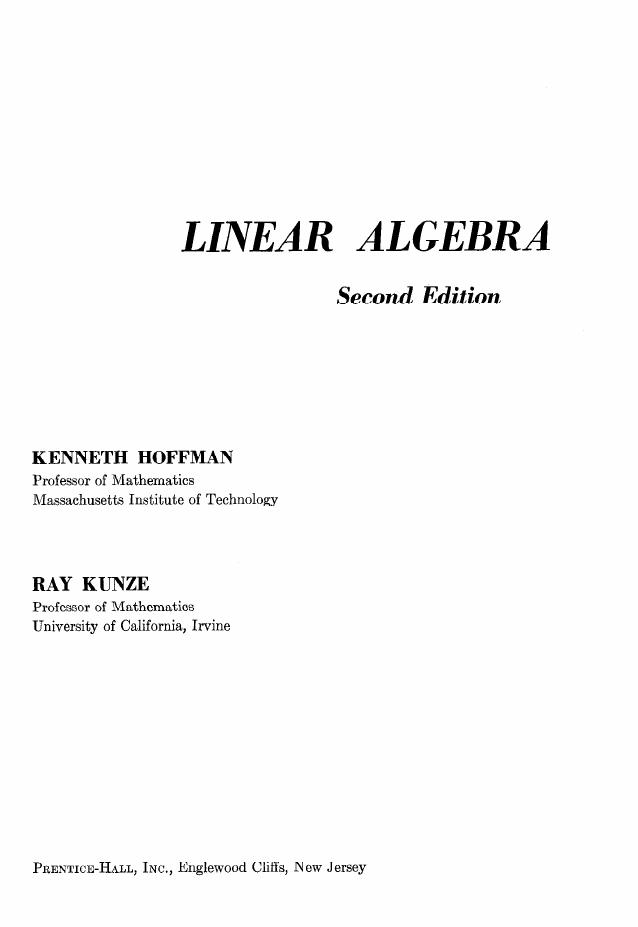
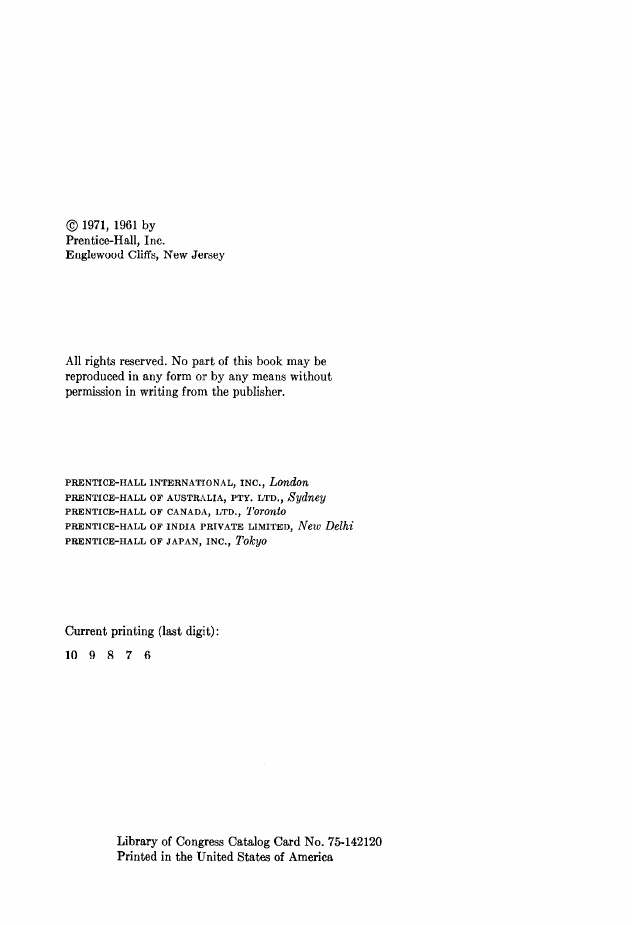
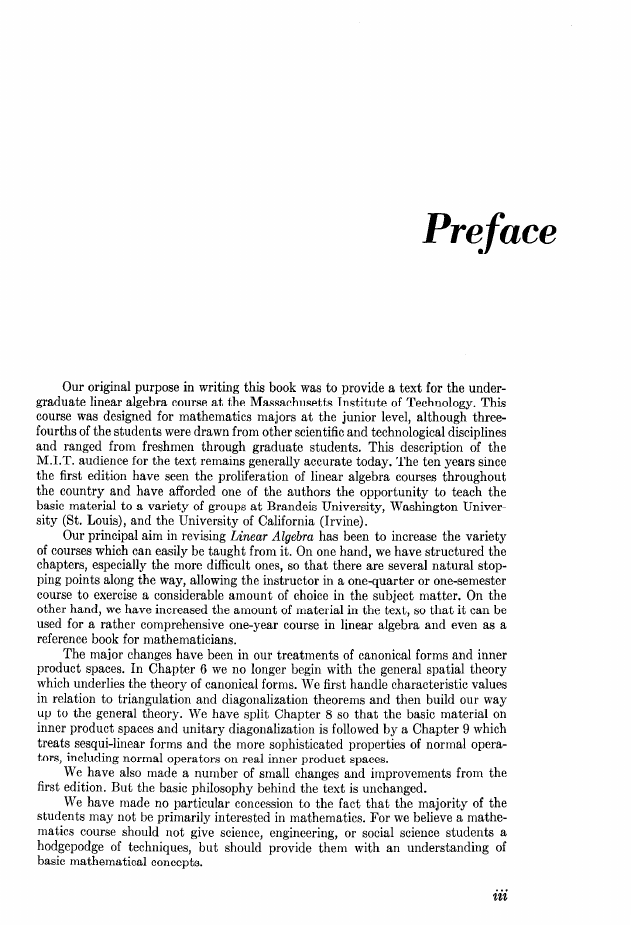
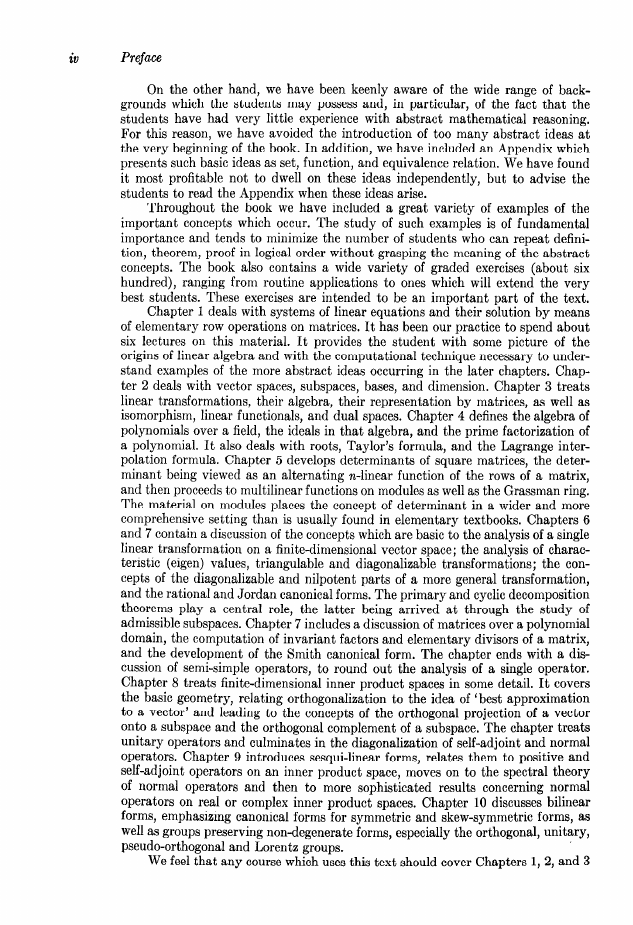
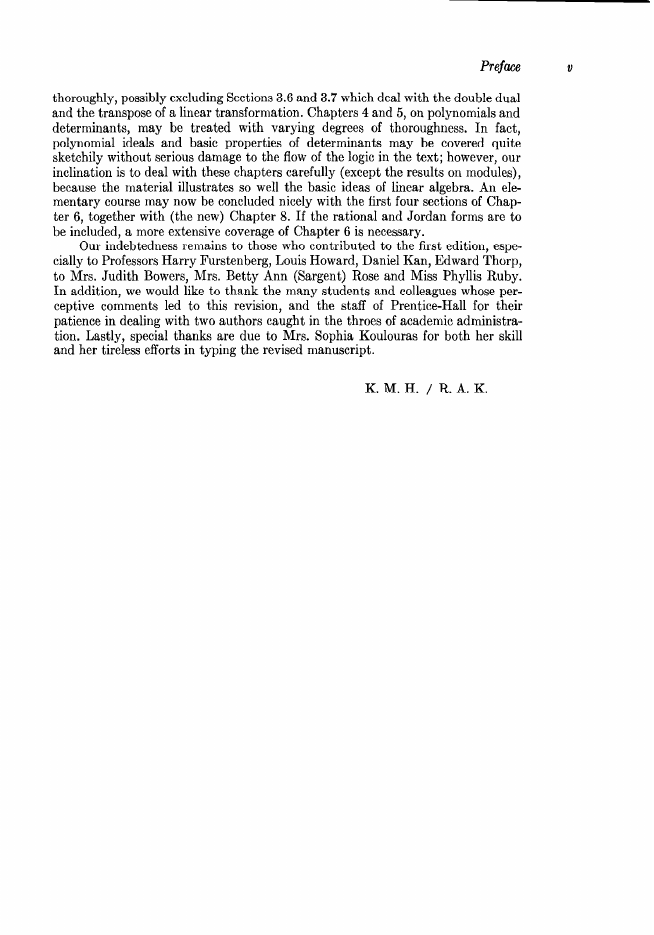
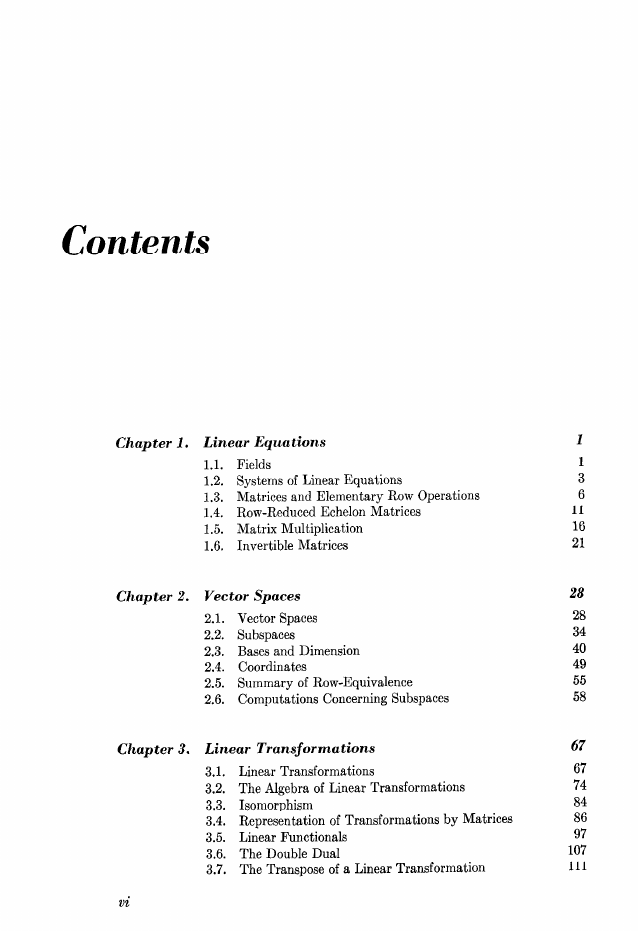

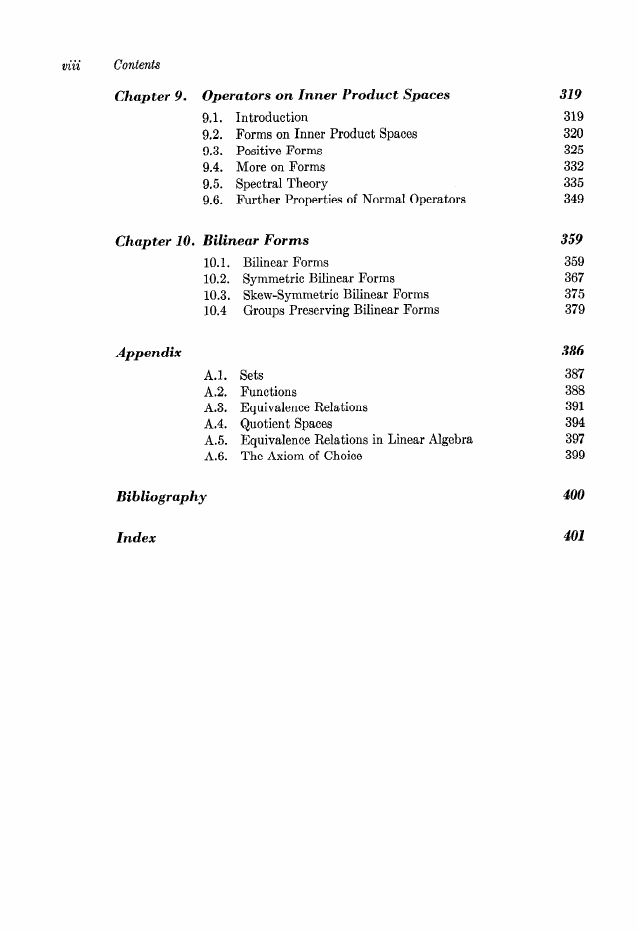








 2023年江西萍乡中考道德与法治真题及答案.doc
2023年江西萍乡中考道德与法治真题及答案.doc 2012年重庆南川中考生物真题及答案.doc
2012年重庆南川中考生物真题及答案.doc 2013年江西师范大学地理学综合及文艺理论基础考研真题.doc
2013年江西师范大学地理学综合及文艺理论基础考研真题.doc 2020年四川甘孜小升初语文真题及答案I卷.doc
2020年四川甘孜小升初语文真题及答案I卷.doc 2020年注册岩土工程师专业基础考试真题及答案.doc
2020年注册岩土工程师专业基础考试真题及答案.doc 2023-2024学年福建省厦门市九年级上学期数学月考试题及答案.doc
2023-2024学年福建省厦门市九年级上学期数学月考试题及答案.doc 2021-2022学年辽宁省沈阳市大东区九年级上学期语文期末试题及答案.doc
2021-2022学年辽宁省沈阳市大东区九年级上学期语文期末试题及答案.doc 2022-2023学年北京东城区初三第一学期物理期末试卷及答案.doc
2022-2023学年北京东城区初三第一学期物理期末试卷及答案.doc 2018上半年江西教师资格初中地理学科知识与教学能力真题及答案.doc
2018上半年江西教师资格初中地理学科知识与教学能力真题及答案.doc 2012年河北国家公务员申论考试真题及答案-省级.doc
2012年河北国家公务员申论考试真题及答案-省级.doc 2020-2021学年江苏省扬州市江都区邵樊片九年级上学期数学第一次质量检测试题及答案.doc
2020-2021学年江苏省扬州市江都区邵樊片九年级上学期数学第一次质量检测试题及答案.doc 2022下半年黑龙江教师资格证中学综合素质真题及答案.doc
2022下半年黑龙江教师资格证中学综合素质真题及答案.doc